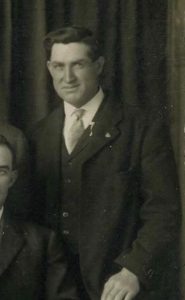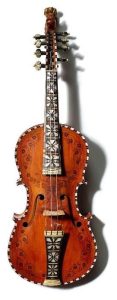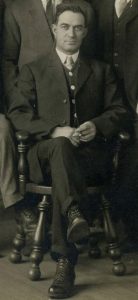The Gordon Brothers
If there was a beginning to what we might consider the “arts” in this family, and their influence in Kearney, it begins with Jerome.
Jerome “Rome” E. Gordon-ca. 1877-1948
Jerome “Rome” E. Gordon-ca. 1877-1948 of Lexington Township, Nebraska, was not one we would typically consider a professional artist, yet he dabbled at both music and art and left an indelible mark of creativity on both his daughter and his grandson who shared innumerable stories about his life.
Jerome was a farmer, raised horses, owned and operated a Mercantile in Kearney, and dealt in wholesale groceries. He was born in Decatur, Mason County, Illinois, March 2, 1877. His parents, Ithial and Sarah Gordon, packed the family up and headed west somewhere between 1882 and 1885 between the births of his brother, Lewis, in Illinois and their sister, Flora, in Plum Creek, (renamed Lexington in 1889) Nebraska. Another sister, Nora, came along in 1887, but the family lost their mother in 1889 when Jerome was just 12 years old. His half-sister Jenny had to grow up quickly, becoming the surrogate mother to her younger siblings at just 16 years old.
In 1901, Jerome married Ida Wilhelmina “Minnie” Anderson, a 20-year-old Swedish emigrant who gave him three children: Ruth, born in 1902, Evelyn, born in 1910 (died in 1911), and a son, Lowell born in 1916. All three children were born in Lexington, Nebraska.
Census records confirm that Jerome and Minnie moved several times. They were in Lexington, Grant, Hastings, and Kearney, Nebraska. While in Kearney, they had a General Mercantile downtown, just south of the tracks on the east side of Central Avenue. Jerome’s brother, Lewis, had a barbershop next door. A family photo showed the interior of the store to be a long, narrow building with old wood and glass display cases down each side, high shelves along the walls, and a cast iron stove in the middle of the room. Jerome was also in the wholesale grocery business. His grandson, Charles Baxter, would go with him on runs to Omaha to buy stock that they brought back to Kearney, which supplied mostly restaurants, one of which was owned by Jerome’s daughter and son-in-law, Ruth and Virgil Hubbard, where Charles also worked as assistant manager for a time.
The Gordons and the Hubbards often lived in the same apartment building, shared living space, or lived in houses right across the street from one another, so Charles was half-raised by his grandparents.
Jerome and his brother Lewis Jewell Gordon-ca. 1882-1967, also played music, and were especially known for playing the Hardanger Fiddle (“hardingfele” in Norwegian) [fig 3]. They played a lot of local dances around Kearney, as learning to play musical instruments was always very popular in families if they could afford one because music was often one of their primary sources of entertainment. Community dances, “barn” dances, weddings, and just simple family gatherings were the avenue for entertainment in small towns and communities before WWII. But folk music lost out to Jazz as the big band era, or swing era, became the most popular music in the United States between 1930 and 1945. After Jerome and Lewis’s deaths, several of their instruments were passed down, including two fiddles, a ukulele, an accordion, harmonicas, and a jaw harp.
The Hardanger Fiddle-hardingfele-has a long and fascinating history in the folklore of Scandinavia. Lore stated that there was a water spirit called the nøkken, also known as the nix, who was an adept fiddler, and for a price would teach other fiddlers all they needed to know about mastering the instrument. One song that grew in popularity and fame for fiddlers to play is called Fanitullen. The Hardanger fiddle is similar to the violin, only it has 8 or 9 strings compared to the violin’s 4 strings. These extra strings cause a reverberating and echoing sound unique to this instrument.
Jerome passed away in 1948 when his grandson Charles was 27. Minnie died in 1976. Charles said that Jerome never pursued woodcarving to any great degree, but like many of the “old-timers” of the day, it was common practice for a man to carry a pocket knife with him, and at any given time, someone, including Jerome, was whittling something from a piece of scrap wood. Many businesses of the day had some form of cast iron or “pot-bellied” wood-burning stove. Many hotels had one in the front foyer; Jerome and Minnie had one in their mercantile. A couple of chairs or a bench usually sat near them, as well as a wooden box or large bucket with firewood. The men would often sit and visit near the stove and whittle.
Unfortunately, none of his woodcarvings have been passed down in the family.


